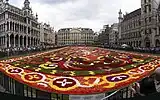| Flower Carpet | |
|---|---|
 Volunteers create the Flower Carpet tapestry | |
| Status | Active |
| Frequency | Biennial |
| Location(s) | City of Brussels, Brussels-Capital Region |
| Country | Belgium |
| Inaugurated | 1971 |
| Most recent | August 15, 2022 |
| Next event | August 15, 2024 |
The Flower Carpet (French: Tapis de Fleurs, Dutch: Bloementapijt) is a biennial event in Brussels in which volunteers from around Belgium convene at the Grand-Place/Grote Markt, the historic centre of the city, to weave a carpet-like tapestry out of colourful begonias.[1] The event takes place every other August, coordinating with Assumption Day.[2] Nearly a million flowers are required to create the ephemeral 1,800 m2 (19,000 sq ft) carpet.[3]
History
The first Flower Carpet was created in 1971 by the Ghent landscape architect Etienne Stautemans in an effort to advertise his work, and due to its popularity, the tradition continued in subsequent years.[4] The Tapis de Fleurs de Bruxelles Association was then created at the initiative of the City of Brussels in cooperation with the Province of Brabant and Les Franc-Bourgeois (a central Brussels traders’ association). The new association laid down the regulations; the event was to be held every two years, for three to four days on the weekend of 15 August and could be enhanced by sound and lighting, fireworks, a jazz concert and other traditional folk entertainments.[5]
Starting in 1986, the event has been regularly held biannually, each time under a different theme, with the Flower Carpet now attracting a large number of local and international visitors.[3]
Description
The tapestry always exhibits tuberous begonias (Begonia tuberosa grandiflora), one of Belgium's major exports since 1860,[6] and occasionally dahlias.[7] More than a hundred volunteers are needed to set up, on a life-size drawing of the transparent and micro-perforated plastic mat, the decoration of grasses and bark where the flowers will be placed, produced on special order by horticulturists in the Ghent region in East Flanders.
Themes
Each year of the Flower Carpet, organisers select a theme for inspiration.[2]
- In 2008, the patterns were inspired by 18th-century French designs and colours.[8]
- In 2010, the carpet honoured Belgian Herman Van Rompuy, the first President of the European Council, with images of historic Belgian symbols alongside the European Union logo.[9]
- In 2012, the carpet exhibited the colours of Africa, inspired by traditional fabrics and tribal costumes.[10]
- In 2014, the carpet paid tribute to the 50th anniversary of Turkish immigrants[3] by imitating the world-famous kilims.[11] Turks came to Belgium in 1964 when both countries signed a bilateral treaty welcoming immigrants during the economic boom.[11]
- In 2016, the carpet displayed a Japanese design to celebrate 150 years of friendship between Belgium and Japan.[12]
- In 2018, the carpet featured cultural elements from the state of Guanajuato, Mexico, including symbolism from the Chupícuaro, Otomí and Purépecha cultures.[13] In addition to the begonias, the carpet included dahlias, the national flower of Mexico.[7]
- In 2020, the event was cancelled due to the COVID-19 pandemic in Belgium.
- In 2022, to mark the event's 50th anniversary and 22nd edition, the pattern was a nod to the first design from 1971. All the elements of this first design were present, including Saint Michael and the Leo Belgicus.[14]
Gallery

.jpg.webp)
See also
References
Citations
- ↑ "Flower Carpet | Anniversary: 20th Flower Carpet! An ephemeral show on the world's most beautiful central square". www.flowercarpet.be. Retrieved 6 February 2016.
- 1 2 "Flower carpet | Event Carnival". Event Carnival. Retrieved 6 February 2016.
- 1 2 3 "Giant Flower Carpet on the Grand Place in Brussels Pays Tribute to Turkish Immigrants". International Business Times UK. Retrieved 6 February 2016.
- ↑ "Flower carpet - City of Brussels". www.brussels.be. Retrieved 6 February 2016.
- ↑ "Coat of Arms of the City of Brussels, where a St. Michael, still valiantly conquering the devil was wreathed with the inscription "Bruxella Civitas Brabantiae"".
- ↑ Forgione, Mary (21 July 2014). "Belgium: When 750,000 begonia flowers come to Brussels' main square". Los Angeles Times. Retrieved 6 February 2016.
- 1 2 "Flores mexicanas tapizan La Grand-Place de Bruselas". Excélsior (in Spanish). 16 August 2018.
- ↑ "A Look at Belgium's Flower Carpets, Made of 750,000 Stems". Curbed. Retrieved 6 February 2016.
- ↑ "Flower Carpet 2010 | Flower Carpet". www.flowercarpet.be. Retrieved 6 February 2016.
- ↑ "Tissus africains pour le Tapis de Fleurs 2012". www.lavenir.net (in French). Retrieved 6 February 2016.
- 1 2 "Brussels Flower Carpet 2014 commemorates Turkish immigration in Belgium." Xinhua News Agency 14 Aug. 2014. Infotrac Newsstand. Web. 6 Feb. 2016.
- ↑ "Flower Carpet 2016 | Flower Carpet". www.flowercarpet.brussels. Retrieved 22 April 2018.
- ↑ Guanajuato lleva tapete de flores monumental a Bruselas (Video) (in Spanish). México Desconocido. 16 August 2018. Event occurs at 5 min 35 sec.
- ↑ "Flower Carpet 2022". www.brussels.be. 7 April 2017. Retrieved 14 August 2022.
External links
 Media related to Flower Carpet (Brussels) at Wikimedia Commons
Media related to Flower Carpet (Brussels) at Wikimedia Commons










_(7794456006).jpg.webp)

.jpg.webp)
_(7794453938).jpg.webp)





